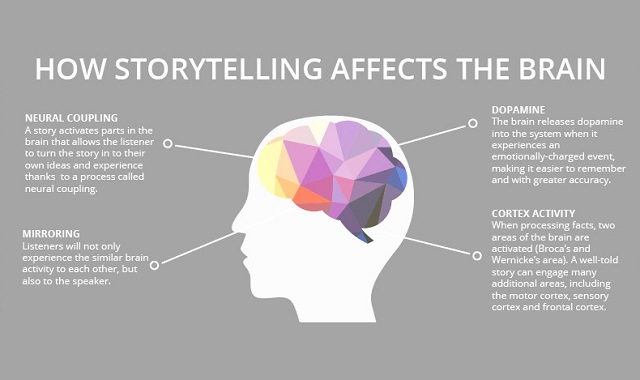
Since humans took their place on Earth, we have been telling stories. From the painting on cave walls, to parables in the Bible, to those told around the dinner table at family gatherings – we pass along our history in an entertaining fashion.
Stories require our brains to work differently than they do when they are processing information. It’s more than putting bullet points in order. When we hear a story, we activate our senses. When a scent is mentioned, our mind recalls the smell. When you mention a color, our mind vividly pulls it to the front of mind. When a movement or action is told, our body knows what motor skills are involved. Our entire being becomes involved when a story is told.
This process creates an emotional attachment to the story. The more our brain fills in, the clearer the message becomes. For those of us who write for a living, that’s powerful information. The more active voice we can use, the more description we can incorporate, the better someone will engage and respond to the story.
Stories also help to bring people together. Shared experiences are powerful connections. When we can relate our own experiences to a story, we feel a connection with the teller and others who are listening.

So how does this translate into internal communications?
When you share stories of success, vision and community, you naturally create a culture of trust and cooperative. It’s a powerful positive connection that is formed. It fosters a sense of team within the company.
Storytelling is a great way to inspire employees and bring everyone together. Think of ways you can paint a picture of your company’s vision for the future. Help employees connect with each other through success stories and personal profiles.
Stories are great when they engage the mind, but they are even more powerful when they engage the heart.
So what kind of stories should you look for and include in your internal communication plan?
Share your wins – big and small. When an individual or department has a win, tell it. Even small wins need telling. Did someone have a suggestion that made something easier? Brag on them.
Consider a “day in the life” series. How does each department or individual contribute to the whole? It gives everyone a glimpse into what happens in all areas of the organization.
Highlight employees who are making a difference outside of 8 to 5. Do they volunteer or do hours of community service? It’s worth telling. Find out why they chose that charity or activity. Make it personal.
It’s important not to forget that internal communication is storytelling too. Using these techniques can add impact and foster stronger engagement from employees.
Why Leaders Can’t Wait: Build Your Team and Workplace Culture Today
Leadership isn’t about waiting for the perfect moment—it’s about taking purposeful action. Discover how you can start building a thriving team and workplace culture today with practical strategies for momentum and success.


